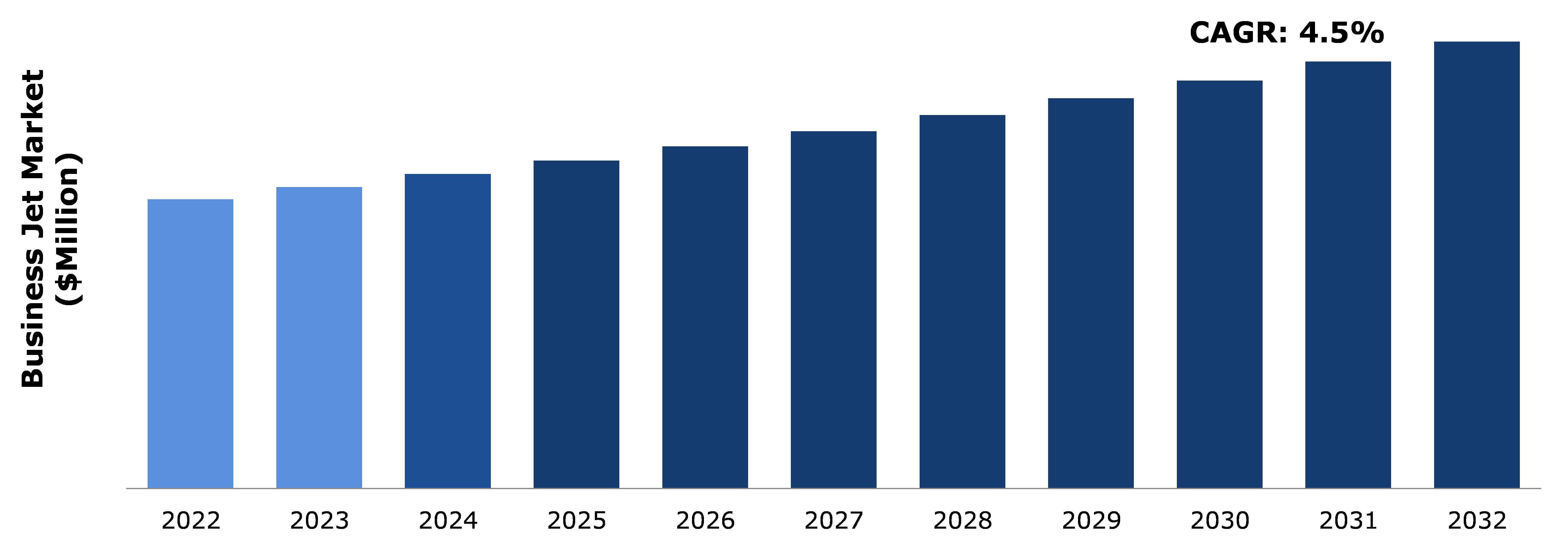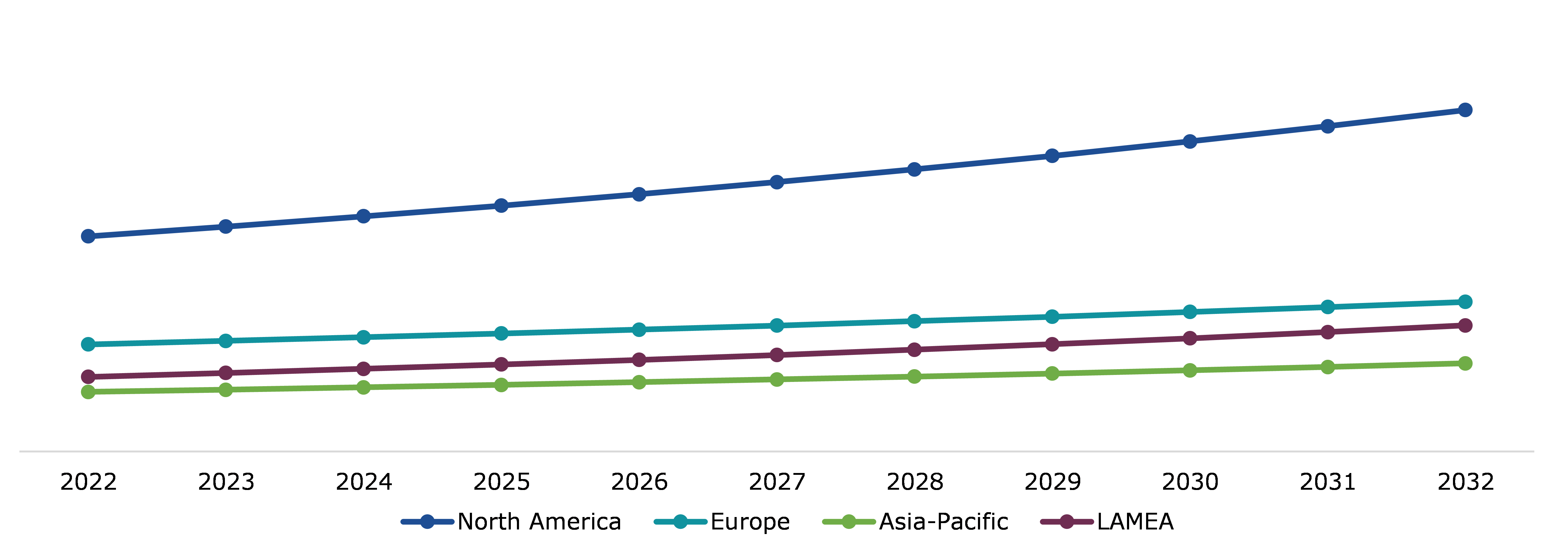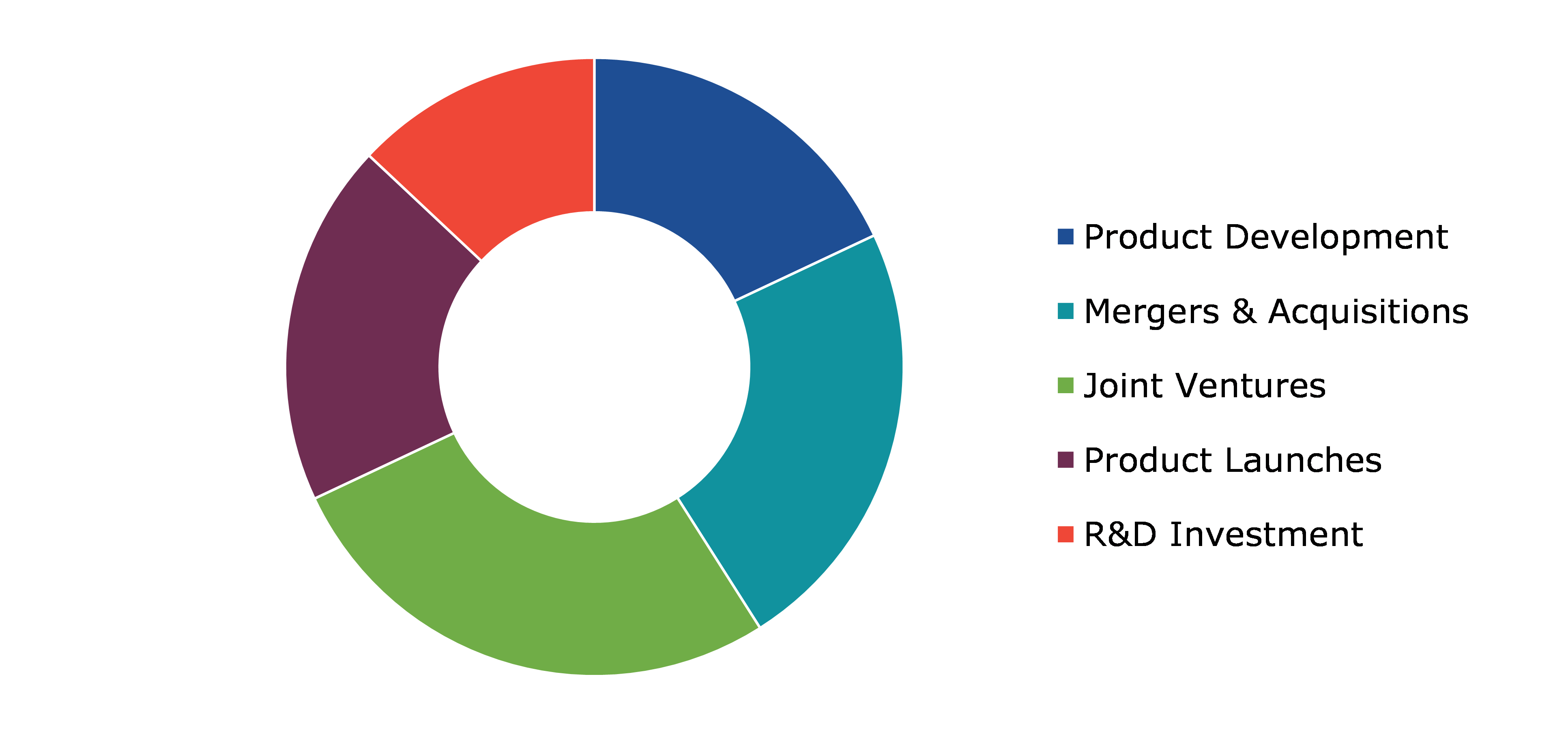Business Jet Market Report
RA09175
Business Jet Market by Type (Very Light Jets, Light Jets, Medium Jets, and Heavy Jets), Category (New and Pre-owned), and Region (North America, Europe, Asia-Pacific, and LAMEA): Global Opportunity Analysis and Industry Forecast, 2023-2032
Business Jet Overview
Business jets, also known as corporate jets or executive jets, are customized aircraft constructed for the sole use of corporations, high-net-worth individuals, government officials, and other wealthy persons. These planes are largely utilized for business and executive travel, providing an accessible and efficient mode of transportation for people who need speed, flexibility, and privacy. Renting a private aircraft might be crucial to the business, especially if a person attends meetings in many cities frequently. Aircraft charter saves time and provides a lot of flexibility as individuals do not have to arrive hours before departure and they may change the schedule as per weather forecasts if required. Furthermore, the private business jet charter allows the user to make the most of their time since, with all of the amenities provided by the business aircraft, they can stay productive on board.
Global Business Jet Market Analysis
The global business jet market size was $26,800.0 million in 2022 and is predicted to grow with a CAGR of 4.5%, by generating a revenue of $41,404.5 million by 2032.
Source: Research Dive Analysis
COVID-19 Impact on Global Business Jet Market
The COVID-19 pandemic led to widespread travel restrictions, social distancing norms, and lockdowns across several countries. These restrictions greatly disrupted business travel that led a negative impact on the business jet market. For instance, many businesses scaled back their operations as well as on-site meetings and conferences during the pandemic. This led to a decline in the demand for business jets as companies cut down their expenses on non-essential travel. In addition, the uncertainties caused by the pandemic led to a temporary halt in business jet manufacturing owing to a drastic decline in the number of new business jet orders. Also, some customers canceled or postponed their orders owing to the economic crisis led by the pandemic.
In the post-pandemic period, the business jet market is gaining significant popularity as the pandemic highlighted the importance of safety and hygiene during air travel. As business jet offers privacy and safer travel environment compared to the commercial airlines, its demand is estimated to increase in the upcoming years.
Time Saving Factor of Business Jets to Drive the Market Growth
The business jet industry is flourishing at a significant rate owing to the convenient travel offered by these jets. With the use of business jets, it is possible for travelers to land at smaller airports which may not be possible with commercial flights. Business jets allow travelers to avoid long check-in lines as well as security queues and time-consuming layovers. Also, business jet provides flexibility with respect to the departure time as travelers can depart as per their schedule and business needs. This is a crucial feature of business jet travel, especially for last-minute trips or changes in travel plans. In addition, the business jet offers a private environment and comfort so that the travelers can work as well as conduct important meetings even during the flight. This is because many planes have Wi-Fi and high-speed Internet access to stay connected while flying. Due to these time-saving features of the business jets, they are the first choice for passengers who want to save their time and increase productivity during travel. These factors are anticipated to drive the business jet market growth during the forecast period.
Necessity of Careful Flight Planning and High Cost of Business Jet to Restrain the Growth of the Market
The high cost associated with owning, maintaining, and operating a business jet is anticipated to restrain market growth in the upcoming years. For instance, the cost of insurance, fuel, aircraft purchase, and crew salaries can increase the cost of business jets thereby affecting their sales. In addition, business jet travel often requires careful flight planning which includes checking the weather condition, routing, as well as fuel stops. This can be a more complex task when compared to booking a commercial flight. Also, business jet operations are subjected to various aviation regulations and safety standards. Hence, complete knowledge of the regulations and compliance is needed before purchasing a private jet. All these are the major factors anticipated to hamper the business jet market revenue growth during the forecast period.
Advanced Avionics, Efficient Engine Design, and Performance to Generate Excellent Opportunities
The newly launched business jets are equipped with state-of-the-art avionics systems which comprise of intuitive interfaces as well as touchscreen display, enhanced navigation, flight management systems, and communication. In addition, some business jets are adopting fly-by-wire technology. With the help of this technology, the business jet uses electronic signals to transmit control inputs instead of mechanical linkages. This is a crucial aspect to enhance the flight stability, precision, and to ensure safety of travelers. Furthermore, the launch of fuel-efficient and environmentally friendly engines helps in noise reduction. Also, business jet offers greater comfort and luxury with the help of efficient interior design facilitated by technological innovations in lighting, use of seating materials, and enhanced layouts. These factors are anticipated to drive the business jet market size in the upcoming years.
Global Business Jet Market Share, by Type, 2022
Source: Research Dive Analysis
The heavy jets sub-segment accounted for the highest market share in 2022. Heavy business jets are also known as large-cabin or long-range business jets that offer various benefits to businesses and individuals. For instance, heavy business jets have the capability to fly longer distances without the need for frequent refueling stops. This feature is crucial for executives and businesses that have operations across the globe. With the help of heavy jets, these businesses can reach distant destinations without the hassle of layovers and commercial airline schedules. Also, heavy business jets offer more privacy and security that is unmatched by commercial flights. For instance, the executives can conduct meetings and even discuss confidential matters during their air travel. These factors are anticipated to boost the heavy business jets market demand in the coming years.
Global Business Jet Market Share, by Category, 2022
Source: Research Dive Analysis
The pre-owned sub-segment accounted for the highest market share in 2022. The popularity of pre-owned business jets can be attributed to several reasons such as cost savings, luxury assets, and slower depreciation compared to the new business jets. For instance, purchasing a new business jet can be extremely expensive. The pre-owned jets that are only a few years old are typically sold at lower prices. Due to this, the buyers enjoy the benefits of private jet ownership without the hefty price tag associated with buying new business jets. In addition, the rate of depreciation tends to slow down as the aircraft gets older. Thus, by purchasing a pre-owned jet, buyers can eliminate the steep initial depreciation that occurs with new jets. These factors are anticipated to boost the pre-owned business jet market expansion during the forecast period.
Global Business Jet Market Size & Forecast, by Region, 2022-2032 ($Million)
Source: Research Dive Analysis
The North America business jet market generated the highest revenue in 2022. The growing popularity of business jets in North America is attributed to its highly advanced infrastructure of airports and Fixed Base Operators (FBOs) that cater specifically to business aviation. These airports and FBOs make it easier for business jet users to access airports closer to their desired destinations thereby avoiding the congestion and logistical challenges linked with commercial airports. The U.S. is home to the largest business jet manufacturers namely The Boeing Company, Gulfstream Aerospace Corporation, and others which hold major market share globally. Furthermore, the U.S. has the Federal Aviation Administration (FAA) which is the part of U.S. Department of Transportation. This organization has set well-defined regulations and certification processes for business jets that ensure the highest safety and quality standards. These aspects are anticipated to drive the North America business jet market growth in the upcoming years.
Competitive Scenario in the Global Business Jet Market
Business expansion and agreement are common strategies followed by major market players. In October 2022, Airbus Corporate Jets (ACJ) increased its presence in the U.S. by expanding its team, visibility, and sales and marketing efforts throughout the country. The aim of ACJ is to penetrate the U.S. market with a new generation of corporate jet aircraft that will be a game changer for the buyers.
Source: Research Dive Analysis
Some of the leading business jet market players are Bombardier Inc., Gulfstream Aerospace Corporation, Textron Aviation Inc., Dassault Aviation, Embraer, Pilatus Aircraft Ltd., Airbus, Cirrus Aircraft, LLC, The Boeing Company, and Honda Aircraft Company LLC.
| Aspect | Particulars |
| Historical Market Estimations | 2020-2021 |
| Base Year for Market Estimation | 2022 |
| Forecast Timeline for Market Projection | 2023-2032 |
| Geographical Scope | North America, Europe, Asia-Pacific, and LAMEA |
| Segmentation by Type |
|
| Segmentation by Category |
|
| Key Companies Profiled |
|
Q1. What is the size of the global business jet market?
A. The size of the global business jet market was over $26,800.0 million in 2022 and is projected to reach $41,404.5 million by 2032.
Q2. Which are the major companies in the business jet market?
A. Bombardier Inc., Gulfstream Aerospace Corporation, and Textron Aviation Inc. are some of the key players in the global business jet market.
Q3. Which region, among others, possesses greater investment opportunities in the future?
A. The LAMEA region possesses great investment opportunities for investors in the future.
Q4. What will be the growth rate of the LAMEA business jet market?
A. The LAMEA business jet market is anticipated to grow at 5.4% CAGR during the forecast period.
Q5. What are the strategies opted by the leading players in this market?
A. Agreement and business expansion are the two key strategies opted by the operating companies in this market.
Q6. Which companies are investing more on R&D practices?
A. Dassault Aviation, Embraer, Pilatus Aircraft Ltd., and Airbus are the companies investing more on R&D activities for developing new products and technologies.
1. Research Methodology
1.1. Desk Research
1.2. Real time insights and validation
1.3. Forecast model
1.4. Assumptions and forecast parameters
1.5. Market size estimation
1.5.1. Top-down approach
1.5.2. Bottom-up approach
2. Report Scope
2.1. Market definition
2.2. Key objectives of the study
2.3. Report overview
2.4. Market segmentation
2.5. Overview of the impact of COVID-19 on global business jet market
3. Executive Summary
4. Market Overview
4.1. Introduction
4.2. Growth impact forces
4.2.1. Drivers
4.2.2. Restraints
4.2.3. Opportunities
4.3. Market value chain analysis
4.3.1. List of raw material suppliers
4.3.2. List of manufacturers
4.3.3. List of distributors
4.4. Innovation & sustainability matrices
4.4.1. Technology matrix
4.4.2. Regulatory matrix
4.5. Porter’s five forces analysis
4.5.1. Bargaining power of suppliers
4.5.2. Bargaining power of consumers
4.5.3. Threat of substitutes
4.5.4. Threat of new entrants
4.5.5. Competitive rivalry intensity
4.6. PESTLE analysis
4.6.1. Political
4.6.2. Economical
4.6.3. Social
4.6.4. Technological
4.6.5. Environmental
4.7. Impact of COVID-19 on business jet market
4.7.1. Pre-covid market scenario
4.7.2. Post-covid market scenario
5. Business Jet Market Analysis, by Type
5.1. Overview
5.2. Very Light Jets
5.2.1. Definition, key trends, growth factors, and opportunities
5.2.2. Market size analysis, by region, 2022-2032
5.2.3. Market share analysis, by country, 2022-2032
5.3. Light Jets
5.3.1. Definition, key trends, growth factors, and opportunities
5.3.2. Market size analysis, by region, 2022-2032
5.3.3. Market share analysis, by country, 2022-2032
5.4. Medium Jets
5.4.1. Definition, key trends, growth factors, and opportunities
5.4.2. Market size analysis, by region, 2022-2032
5.4.3. Market share analysis, by country, 2022-2032
5.5. Heavy Jets
5.5.1. Definition, key trends, growth factors, and opportunities
5.5.2. Market size analysis, by region, 2022-2032
5.5.3. Market share analysis, by country, 2022-2032
5.6. Research Dive Exclusive Insights
5.6.1. Market attractiveness
5.6.2. Competition heatmap
6. Business Jet Market Analysis, by Category
6.1. New
6.1.1. Definition, key trends, growth factors, and opportunities
6.1.2. Market size analysis, by region, 2022-2032
6.1.3. Market share analysis, by country, 2022-2032
6.2. Pre-owned
6.2.1. Definition, key trends, growth factors, and opportunities
6.2.2. Market size analysis, by region, 2022-2032
6.2.3. Market share analysis, by country, 2022-2032
6.3. Research Dive Exclusive Insights
6.3.1. Market attractiveness
6.3.2. Competition heatmap
7. Business Jet Market, by Region
7.1. North America
7.1.1. U.S.
7.1.1.1. Market size analysis, by Type, 2022-2032
7.1.1.2. Market size analysis, by Category, 2022-2032
7.1.2. Canada
7.1.2.1. Market size analysis, by Type, 2022-2032
7.1.2.2. Market size analysis, by Category, 2022-2032
7.1.3. Mexico
7.1.3.1. Market size analysis, by Type, 2022-2032
7.1.3.2. Market size analysis, by Category, 2022-2032
7.1.4. Research Dive Exclusive Insights
7.1.4.1. Market attractiveness
7.1.4.2. Competition heatmap
7.2. Europe
7.2.1. Germany
7.2.1.1. Market size analysis, by Type, 2022-2032
7.2.1.2. Market size analysis, by Category, 2022-2032
7.2.2. France
7.2.2.1. Market size analysis, by Type, 2022-2032
7.2.2.2. Market size analysis, by Category, 2022-2032
7.2.3. UK
7.2.3.1. Market size analysis, by Type, 2022-2032
7.2.3.2. Market size analysis, by Category, 2022-2032
7.2.4. Switzerland
7.2.4.1. Market size analysis, by Type, 2022-2032
7.2.4.2. Market size analysis, by Category, 2022-2032
7.2.5. Austria
7.2.5.1. Market size analysis, by Type, 2022-2032
7.2.5.2. Market size analysis, by Category, 2022-2032
7.2.6. Rest of Europe
7.2.6.1. Market size analysis, by Type, 2022-2032
7.2.6.2. Market size analysis, by Category, 2022-2032
7.2.7. Research Dive Exclusive Insights
7.2.7.1. Market attractiveness
7.2.7.2. Competition heatmap
7.3. Asia-Pacific
7.3.1. China
7.3.1.1. Market size analysis, by Type, 2022-2032
7.3.1.2. Market size analysis, by Category, 2022-2032
7.3.2. Japan
7.3.2.1. Market size analysis, by Type, 2022-2032
7.3.2.2. Market size analysis, by Category, 2022-2032
7.3.3. India
7.3.3.1. Market size analysis, by Type, 2022-2032
7.3.3.2. Market size analysis, by Category, 2022-2032
7.3.4. Australia
7.3.4.1. Market size analysis, by Type, 2022-2032
7.3.4.2. Market size analysis, by Category, 2022-2032
7.3.5. South Korea
7.3.5.1. Market size analysis, by Type, 2022-2032
7.3.5.2. Market size analysis, by Category, 2022-2032
7.3.6. Rest of Asia-Pacific
7.3.6.1. Market size analysis, by Type, 2022-2032
7.3.6.2. Market size analysis, by Category, 2022-2032
7.3.7. Research Dive Exclusive Insights
7.3.7.1. Market attractiveness
7.3.7.2. Competition heatmap
7.4. LAMEA
7.4.1. Brazil
7.4.1.1. Market size analysis, by Type, 2022-2032
7.4.1.2. Market size analysis, by Category, 2022-2032
7.4.2. Argentina
7.4.2.1. Market size analysis, by Type, 2022-2032
7.4.2.2. Market size analysis, by Category, 2022-2032
7.4.3. UAE
7.4.3.1. Market size analysis, by Type, 2022-2032
7.4.3.2. Market size analysis, by Category, 2022-2032
7.4.4. South Africa
7.4.4.1. Market size analysis, by Type, 2022-2032
7.4.4.2. Market size analysis, by Category, 2022-2032
7.4.5. Rest of LAMEA
7.4.5.1. Market size analysis, by Type, 2022-2032
7.4.5.2. Market size analysis, by Category, 2022-2032
7.4.6. Research Dive Exclusive Insights
7.4.6.1. Market attractiveness
7.4.6.2. Competition heatmap
8. Competitive Landscape
8.1. Top winning strategies, 2022
8.1.1. By strategy
8.1.2. By year
8.2. Strategic overview
8.3. Market share analysis, 2022
9. Company Profiles
9.1. Bombardier Inc.
9.1.1. Overview
9.1.2. Business segments
9.1.3. Product portfolio
9.1.4. Financial performance
9.1.5. Recent developments
9.1.6. SWOT analysis
9.2. Gulfstream Aerospace Corporation
9.2.1. Overview
9.2.2. Business segments
9.2.3. Product portfolio
9.2.4. Financial performance
9.2.5. Recent developments
9.2.6. SWOT analysis
9.3. Textron Aviation Inc.
9.3.1. Overview
9.3.2. Business segments
9.3.3. Product portfolio
9.3.4. Financial performance
9.3.5. Recent developments
9.3.6. SWOT analysis
9.4. Dassault Aviation
9.4.1. Overview
9.4.2. Business segments
9.4.3. Product portfolio
9.4.4. Financial performance
9.4.5. Recent developments
9.4.6. SWOT analysis
9.5. Embraer
9.5.1. Overview
9.5.2. Business segments
9.5.3. Product portfolio
9.5.4. Financial performance
9.5.5. Recent developments
9.5.6. SWOT analysis
9.6. Pilatus Aircraft Ltd.
9.6.1. Overview
9.6.2. Business segments
9.6.3. Product portfolio
9.6.4. Financial performance
9.6.5. Recent developments
9.6.6. SWOT analysis
9.7. Airbus
9.7.1. Overview
9.7.2. Business segments
9.7.3. Product portfolio
9.7.4. Financial performance
9.7.5. Recent developments
9.7.6. SWOT analysis
9.8. Cirrus Aircraft, LLC
9.8.1. Overview
9.8.2. Business segments
9.8.3. Product portfolio
9.8.4. Financial performance
9.8.5. Recent developments
9.8.6. SWOT analysis
9.9. The Boeing Company
9.9.1. Overview
9.9.2. Business segments
9.9.3. Product portfolio
9.9.4. Financial performance
9.9.5. Recent developments
9.9.6. SWOT analysis
9.10. Honda Aircraft Company, LLC
9.10.1. Overview
9.10.2. Business segments
9.10.3. Product portfolio
9.10.4. Financial performance
9.10.5. Recent developments
9.10.6. SWOT analysis
Personalize this research
- Triangulate with your own data
- Request your format and definition
- Get a deeper dive on a specific application, geography, customer or competitor
- + 1-888-961-4454 Toll - Free
- support@researchdive.com






